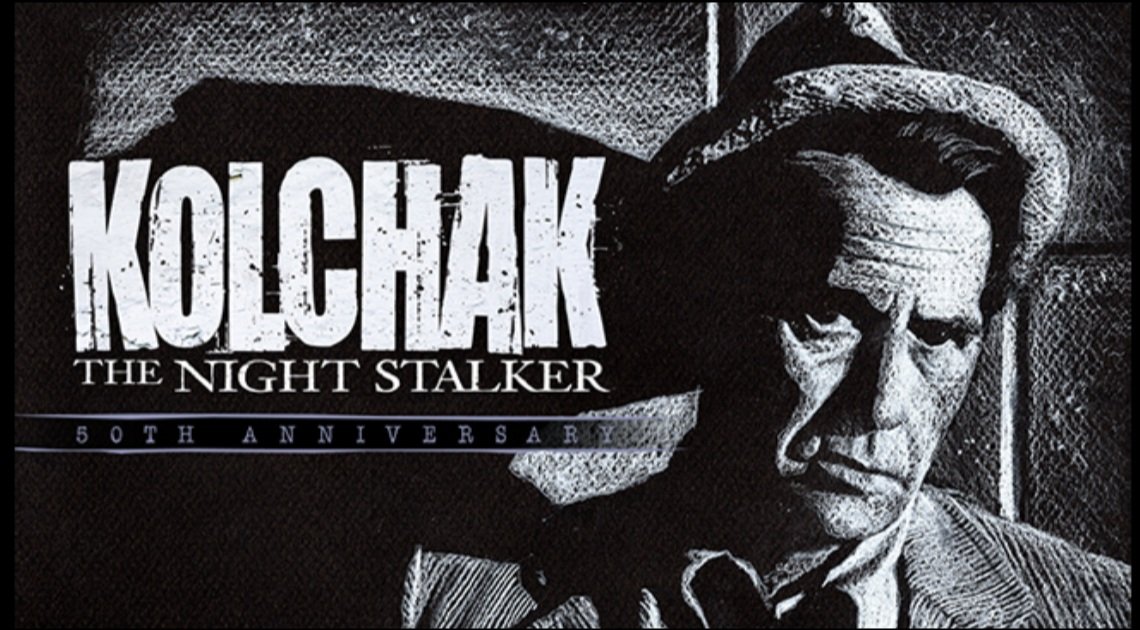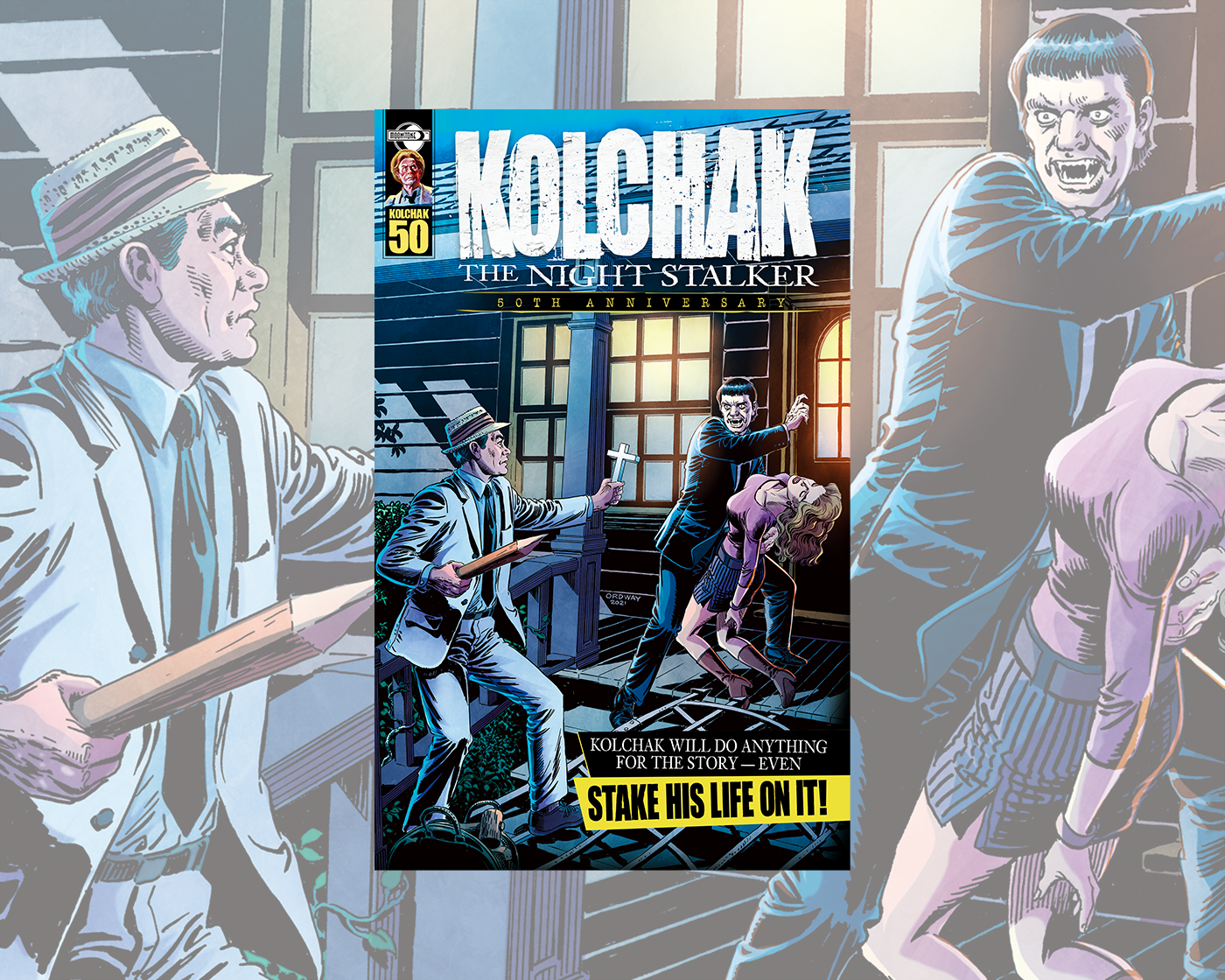Modern Monsters: Kolchak Meets the Classics
By Jessica Dwyer
The ‘70s were an interesting time in the realms of TV and film. It was fearless and vicious when it came to story and content. Add to that a serious return of interest to the supernatural in the public at large and things got spooky fast.
Enter into this equation Dan Curtis who had already brought classic monsters into the family home with Dark Shadows in the late ‘60s. When Curtis joined forces with Richard Matheson to bring Jeff Rice’s Kolchak to viewers in 1972 it was part of a mass migration of monsters and myths in films and TV that would reign over the decade.
Specifically in 1972 there were a number of classic monsters that saw a resurgence in the public eye. Blacula, Dracula, werewolves, and even the odd cannibal would be everywhere. But The Night Stalker, with its TV movie of the week, would specifically showcase a monster at ease and being able to live (such as it was) in a modern world and thrive.
With the next entry into Kolchak’s ever expanding byline we’d see The Night Strangler, a creature (you couldn’t really consider him a man anymore) progressing through time and having to kill every 21 years to keep his immortality. Once again, this film shows a supernatural entity managing to keep himself active within the modern day, finding a way to keep his secret and stay hidden, at least for some time, in plain sight.
Get 10% off all our Kolchak books and merch
Use discount code: STOKER10
As Kolchak’s world expanded into a weekly series, so did the types of creatures roaming the modern world. The series was brilliant and unique, leading the way in creating an urban setting where mythological creatures and beings would be able to live among us, some of them using their abilities to advance within our world and others simply surviving. In many ways, Kolchak was the first time we’d see on screen an urban fantasy/horror setting, the type that would become a staple of books and TV in the last 20-plus years with entries like True Blood, Harry Dresden, and more.
There was an increased interest during the ‘60s into the supernatural and folklore, with alternate beliefs like Witchcraft, a return to Paganism, and looking beyond the norm that followed into the ‘70s and Kolchak’s world would take that and run with it (hence the sneakers).
Films like The Deathmaster, which would be released in 1972 and star Robert Quarry as a vampire cult leader (Quarry was up for the vampire role in The Night Stalker), would combine the old-school vampire myth with the troubling, current trend of cults. Referencing the Manson family, the film would meld the classic monster with the current one with horrifying results.
Robert Quarry and Brenda Dickson in Deathmaster
Carl Kolchak’s investigations would take things further and in brilliant ways. The first of these would involve a true horror story coming into modern times that had happened less than a 100 years earlier when Kolchak took on Jack the Ripper. Kolchak would make The Ripper into a long-lived villain who would show up throughout history. While this mirrored in many ways the plot from The Night Strangler, the terror that the Ripper was in fact very real and would have copycats throughout history only added to the horror. This would be hammered home with the way the ‘70s and early ‘80s would be a terrible renaissance for serial killers in the U.S. Some of these would have more than a little supernatural overtones to their natures, one of which would be called, ironically, The Night Stalker.
The episode “Bad Medicine” features the legend of the Diablero, a native American legend. In the episode, the spirt of a Diablero, which is a Native American warlock and shapeshifter is released and must fulfill his curse of obtaining 13 treasures to make up for his sacrilegious act. The story features the Diablero preying on the rich and affluent (for the most part) and in a way you can see this as a revenge tale for how the Native American tribes were treated and their own riches (i.e. their land) were taken by, most likely, the ancestors of those he is preying on.
Richard Kiel as The Diablero
This episode aired in 1974, only a year before the Wounded Knee Occupation, during which Lakota tribesmen and American Indian Movement members took over the town of Wounded Knee to protest the treatment of the Native American peoples. Just a year earlier, the Trail of Broken Treaties, a protest that went from the West to the East Coasts, happened. Before this, only a few years prior, there was the Occupation of Alcatraz, which threw a light on American Indian’s plight and uprising against what had been done to them. It’s hard not to think this episode was a subversive nod to what was happening in the world at the time.
This could also be said about the episode “The Energy Eater,” which is literally about a Native American god named Matchemonedo feeding off the energy and destroying a large high-tech hospital that’s been built on top of Native American land. The actual myth calls Matchemonedo an evil spirit. Yet again it’s hard to fault what is going on, but you can feel bad about the victims who in some cases were just trying to get well.
Politics, as you can imagine, was a battleground in the ‘70s. One of the more memorable episodes of The Night Stalker showed just how demonic many voters saw their options in “The Devil’s Platform.” The episode starred Tom Skerritt as a politician (named Robert Palmer no less) who has sold his soul to the Devil in exchange for success, even at the cost of the lives of all those who oppose him. Palmer’s interest in the occult was something, as previously said, on the rise in the late ‘60s and early ‘70s. But his literal deal with the Devil was a bit more out of the norm.
It's interesting to note that “The Devil’s Platform” predated Omen 3: The Final Conflict by seven years. That film featured a charismatic politician in the form of Damien Thorn, whose rise in the ranks of politics had everything to do with the influence of the Devil himself.
The original television film would have a sequel in the episode “The Vampire,” which would find one of Janos Skorzeny’s unknown victims, a “lady of the night” leaving Las Vegas and coming to Los Angeles to start preying on the rich and famous. Having been the prey for men during her time alive, Catherine Rawlins turns the tables and uses her time as a call girl before becoming a vampire to live and work and feed in the City of Angels. If not for Kolchak’s knowledge and a quirk of fate having him assigned to cover a story there, Catherine would probably have kept going with no one the wiser.
Speaking of Catherine, The Night Stalker was probably one of the most equal opportunity genre series when it came to the monsters of the week being women. With the release of The Exorcist only a year prior, in ‘73, it was evident women could be as creepy and terrifying as any man. Within the realms of The Night Stalker, there were a number of women alongside Catherine who would give Kolchak a run for his money.
Helen of Troy herself returned, using the trappings of the new (at the time) tech of computer dating to lure young men and take their youth to keep herself alive and appease the goddess Hecate. “The Youth Killer” took a stab at not only the risks of the new dating scene but also the ever present desire to stay young and beautiful, one that with the rise of plastic surgery and advancements in the decade became a big deal (and big money.)
But perhaps one of my favorites and the one that nearly beat Kolchak was one of the classic myths come to the present and used their power in a way truly modern. “The Trevi Collection” featured Laura Parker as Madeline, a witch with a taste for fashion. Parker had already played one of the greatest witches in TV or any format really with Angelique in Dark Shadows, and she knew how to turn on the laughter mania that was needed to make a truly terrifying one.
Madeline was using her magic to become one of the most beautiful and powerful models in the New York fashion scene. Madeline’s end doesn’t result in her demise but a fate for her that’s probably worse than death as Kolchak exposes her as a witch in public and causes her to be covered in a terrible scarring pox from the Middle Ages that destroys her beauty and her mind along with her powers.
There’s no telling how long Madeline had been around, but considering how ancient the disease that riddled her was, it was probably quite a while. With her desire to be a part of the modern world and her Old World ways of getting what she wanted, Madeline personified what Kolchak did brilliantly. Kolchak brought the classics to life and gave us magnificent modern monsters.
ABOUT THE AUTHOR
Jessica Dwyer grew up comfortable in a world filled with the macabre of late-night creature features and sci-fi rubber monsters. From a young age she was drawn to the darker side of Universal Horror Movies, Hammer Films, and strange TV series that most 5-year-olds would be terrified of like The Night Stalker and Dark Shadows. It continued into a love of science fiction with Doctor Who, Star Trek, and V. It wasn’t just TV & movies for Jessica as she dived into a world filled with books by authors like Clive Barker, Edgar Allan Poe, and HP Lovecraft. Comic books were read by the box full as were Famous Monsters of Filmland, Fangoria, and Gorezone.
Jessica has written for numerous magazines and websites covering the entertainment industry and is a multiple Rondo Award nominee. She’s written fiction and non-fiction books and shorts including the first entry of a Sweeney Todd trilogy, Silver and Rubies. Jessica’s also a producer having completed the documentaries In Search of Darkness 1 & 2 and In Search of Tomorrow. She writes and narrates the JoBlo Network series Fantasizing About Fantasy Films, WTF Happened To This Horror Star, Mytheries, and Gone But Not Forgotten. Her online webzine and YouTube channel, Fangirl Magazine, is still going strong as is her radio show/podcast Fangirl Radio which gives the point of view of female fans of horror, sci-fi, and other genres in the world of entertainment.





